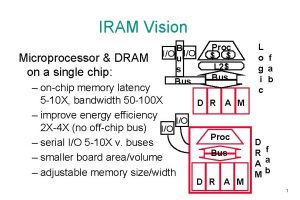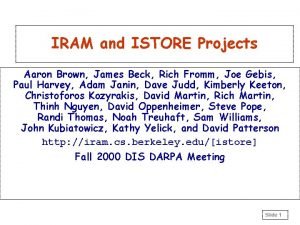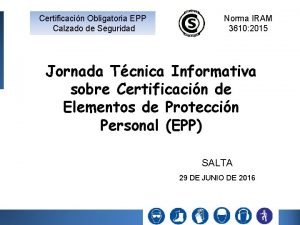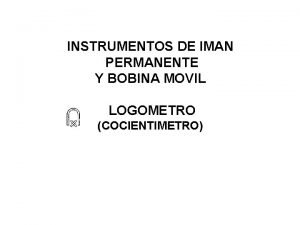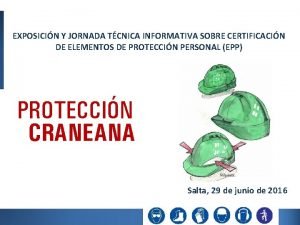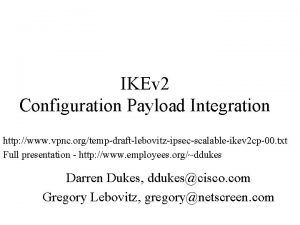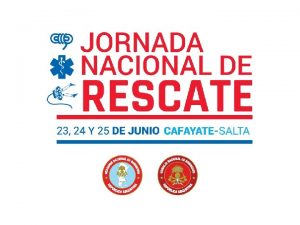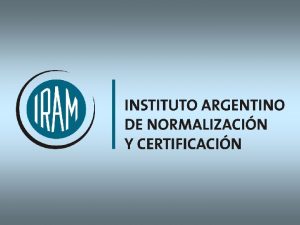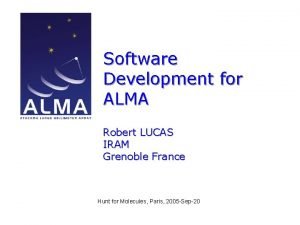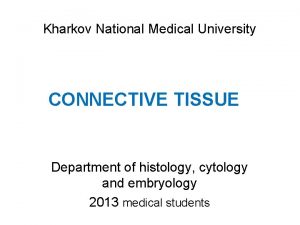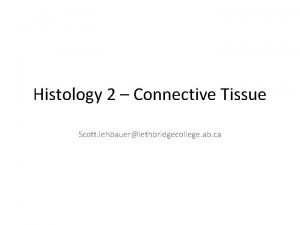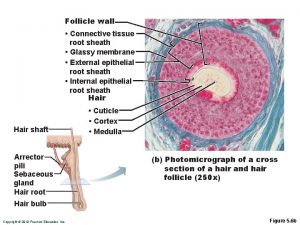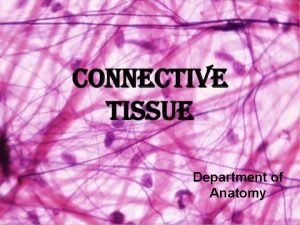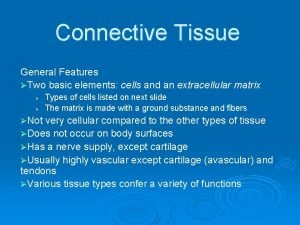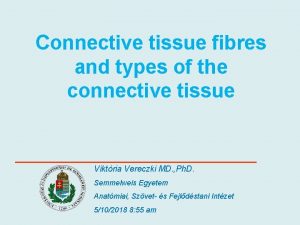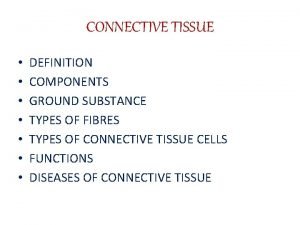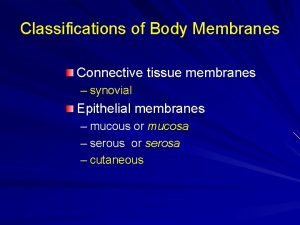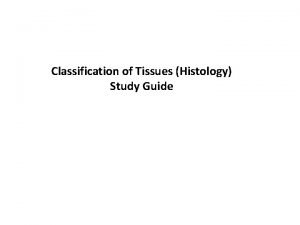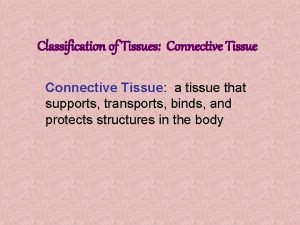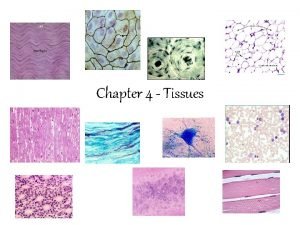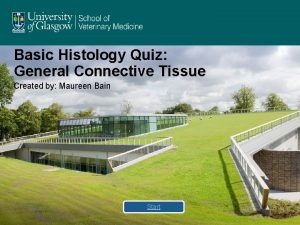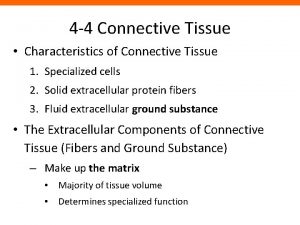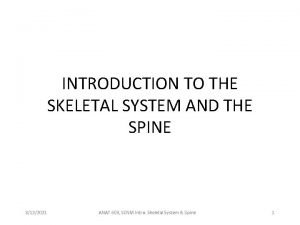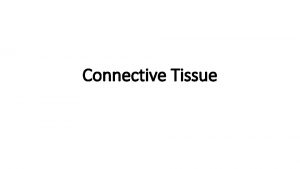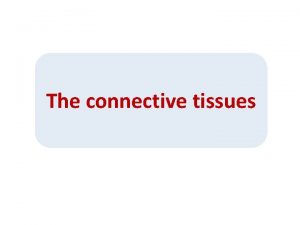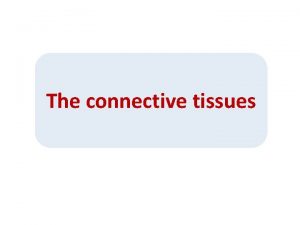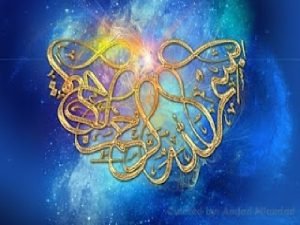CONNECTIVE TISSUE Dr Iram Tassaduq INTRODUCTION Connective tissue

































- Slides: 33


CONNECTIVE TISSUE Dr Iram Tassaduq

INTRODUCTION ‘Connective tissue’ is the term traditionally applied to a basic type of tissue of mesodermal origin which provides structural and metabolic support for other tissues and organs throughout the body, also known as “Supporting tissue”.

COMPOSITION q Cells q Fibers q Ground substance


FUNCTIONS Establishing a structural framework q Supporting, surrounding and interconnecting tissues q Exchange of nutrients and waste products q Storing energy reserves q Defending the body from microorganisms q Protecting delicate organs q

CLASSIFICATION CONNECTIVE TISSUE Embryonic Adult

EMBRYONIC CONNECTIVE TISSUE MESENCHYMAL MUCOUS

ADULT CONNECTIVE TISSUE PROPER SPECIALIZED CONNECTIVE TISSUE


SPECIALIZED CONNECTIVE TISSUE CARTILAGE ELASTI C HYALINE BONE FIBRO CARTILAGE COMPACT SPONGY

CELLS OF CONNECTIVE TISSUE q q q RESIDENT CELLS Fibroblasts Macrophages Adipose cells Mast cell Plasma cells WANDERING CELLS q Lymphocytes q Plasma cells q Neutrophils q Eosinophils q Basophils q Monocytes

FIBROBLASTS One of the two most numerous cells of C. T. q Large, flat cells with branching processes and appear fusiform in profile. q Young fibroblasts q Mature/inactive fibroblasts q

FIBROBLASTS q q Section of rat skin. A connective tissue layer (dermis) shows q several fibroblasts, which are the elongated cells. (H&E) stain. Most common cells Synthesize proteins, such as collagen and elastin that forms collagen, reticular, and elastic fibers Secrete “Ground Substance” Involved in production of “Growth Factors” Wound healing

• Fibroblasts that are actively engaged in synthesis are richer in mitochondria, lipid droplets, Golgi complex, and rough endoplasmic reticulum than are quiescent fibroblasts (fibrocytes).


MACROPHAGES (HISTIOCYTES) Almost as numerous as fibroblasts q Most abundant in richly vascularized areas q Fixed/resting macrophages q Free/wandering macrophages q

MACROPHAGES q q q q Size 10 -30 µm Oval or kidney shaped nucleus located eccentrically Monocytes-Marophages Kupffer cells-liver, microglial cells-CNS, osteoclasts- bone tissue Phagocytosis Have well-developed Golgi complex, many lysosomes, and a prominent rough endoplasmic reticulum ‘Foreignbody giant cell’

IN RESTING PHASE Appear as irregular cells with short and blunt processes but sometimes the processes may be long, slender and branching. q Nucleus is rounder, smaller and more heterochromatic than that of fibroblast. q Cytoplasm stains darkly & may contain few small vacuoles q

IN ACTIVE STATE Cell becomes larger with bigger nucleus and prominent nucleolus q Cytoplasm becomes filled with granules and vacuoles, containing ingested material q


FUNCTIONS OF MACROPHAGES Important agent of defense and part of Mononuclear phagocyte system. q These are secretory cells that produces several important substances including enzymes and proteins of complement system q They play very important role in immune system and act as antigen presenting cells. q They are capable of motility and when suitably stimulated grouped around a large foreign body to form multinucleated foreign body giant cells q

ADIPOSE CELLS The large mesenchymal cells after accumulation of fat droplets in their cytoplasm are called adipocytes q Occur singly or in clumps along small blood vessels q

ADIPOSE CELLS q q q Also called “Fat Cells” Size 50 -150 µm Cytoplasm is dispalced to periphery by a single large fat droplet Nucleus is pressed against the cell membrane “Signet ring” Functions in energy reserves, insulation, protection, and support

TYPES OF ADIPOSE TISSUE q White or unilocular q Brown or multilocular

UNILOCULAR FAT q q q Also called white fat Widely distributed in body Main component of adult fat Single fat droplet in cytoplasm Cells show signet ring appearance

MULTILOCULAR FAT q q q Also called brown fat Mainly found in children Multiple small fat droplets Help in heat production Rich blood supply Numerous mitochondria

MAST CELLS Mast means well fed. Their cytoplasm is full of coarse granules so this name is given. q Tend to occur in small groups around blood vessels. q Irregularly oval in outline, have short pseudopodia q Nucleus is small being crowded by large number of prominent granules q

FUNCTIONS OF MAST CELLS q As these granules contain heparin (a powerful anticoagulant) and histamine (a potent vasodilator) so they play very vital role in homeostasis.

METACHROMASIA

PLASMA CELLS q q q q Portion of a chronically inflamed intestinal villus. PT stain Large, ovoid cells Nucleus is spherical and eccentrically placed ‘cart-wheel appearance’ Basophilic cytoplasm due to abundant RER Rare in most connective tissues Produce antibodies Average life is short, 10– 20 days


 Iram 3801
Iram 3801 Appistore
Appistore Iram-aaron
Iram-aaron Norma iram 3610
Norma iram 3610 Bobina movil e iman permanente
Bobina movil e iman permanente Iram 3620 casco de seguridad para uso industrial
Iram 3620 casco de seguridad para uso industrial Iram attr
Iram attr Iram 3626
Iram 3626 Iram 3625
Iram 3625 Iram
Iram Normas iram cursogramas
Normas iram cursogramas Iram software
Iram software Iram grenoble
Iram grenoble Specialized connective tissues
Specialized connective tissues Description of nerve tissue
Description of nerve tissue Dense irregular connective tissue
Dense irregular connective tissue Dense regular connective tissue
Dense regular connective tissue Follicle wall diagram
Follicle wall diagram Regular connective tissue
Regular connective tissue Elastic tissue location and function
Elastic tissue location and function Identify connective tissue quiz
Identify connective tissue quiz Areolar tissue
Areolar tissue Multiadhesive glycoproteins
Multiadhesive glycoproteins Connective tissue components
Connective tissue components Connective tissue cells
Connective tissue cells Areolar vs reticular connective tissue
Areolar vs reticular connective tissue Types of body membranes
Types of body membranes Tissue type
Tissue type Connective tissue
Connective tissue Connective tissue description
Connective tissue description Connective tissue histology quiz
Connective tissue histology quiz Four basic tissues
Four basic tissues Connective tissue characteristics
Connective tissue characteristics Embryonic connective tissue
Embryonic connective tissue

